The Eighties Club
The Politics and Pop Culture of the 1980s
|
Cartoons of the '80s
|
ALF
NBC, 1987-90, Alien Prod., Saban, DiC
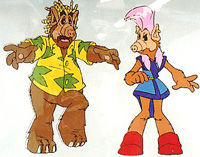 Gordon Shumway, aka ALF (Alien Life Form) was from the planet Melmac. He crash-landed in the garage of a family named Tanner and the rest, as they say, is history. One year after the smash-hit sitcom debuted, NBC introduced an animated ALF to its Saturday morning lineup. In the cartoon, ALF is still on Melmac with his family, and their everyday lives are a vehicle for a relentless spoofing of American culture. In 1988, the show was expanded to one hour with the addition of Alf Tales, which presented Gordon and his family in send-ups of various classic fairy tales.
The Berenstain Bears
CBS, 1985-87, Southern Star & Hanna-Barbera
  Featuring the characters from Jan Berenstain's bestselling children's books, this series was as wholesome and family-oriented as they come. The stories revolved around the family's relationship with one another and their community. Occasionally they had to deal with the rascally Raffish Ralph. Ruth Buzzi provided the voice for Mama Bear.
The California Raisins
CBS, 1989-90, Murakami-Wolf-Swenson
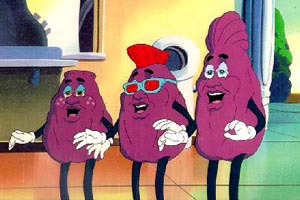 Inspired by the popular commercials launched by the California Raisin Advisory Board with the help of claymation expert Will Vinton, this show featured traditional cel animation rather than claymation. A.J., Red, Beebop and Stretch -- the raisins were named in a 1988 Name-The-Raisin contest -- were the musically-inclined stars. Unable to replicate the charm and novelty of the commercials, the series was cancelled after one season. The concept spawned plenty of tie-in merchandise which is now collectible. In July 1989, the "Michael Raisin" ad, featuring a clay figure of Michael Jackson, debuted in theaters. And there was a 1990 TV special, The Raisins: Sold Out.
The Care Bears
ABC, 1985, 1987; Those Characters From Cleveland & DiC
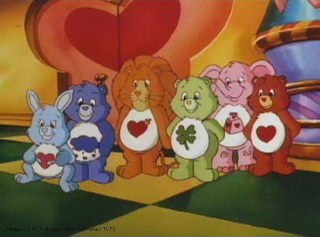 Created in 1981 by American Greetings, the Care Bears soon became so popular that there were toys, books, a television special, and a movie (1985) before they joined ABC's Saturday morning lineup. The Care Bears -- Funshine Bear, Cheer Bear, Grumpy Bear, etc. -- hailed from a world called Care-A-Lot, and would come to Earth to lend a boy or girl a helping hand. The preschool set loved them and so did the parents, who appreciated the series for teaching wholesome values.
Danger Mouse
Nickelodeon, 1985-87, Cosgrove/Hall Productions
 For 89 episodes, the "Greatest Secret Agent in the World" foiled the evil schemes of Baron Silas Greenback (a toad) and his henchmen Stiletto and Leatherhead (a pair of crows), aided by Penfold (a hamster) and his boss, Colonel K (a walrus). Danger Mouse originated in Britain and became an immediate hit when introduced to the U.S. a few years later. Adults loved the show's sly political and social satire. A spin-off series featured another villain, Count Duckula
Dungeons & Dragons
CBS, 1983-87; Marvel Productions
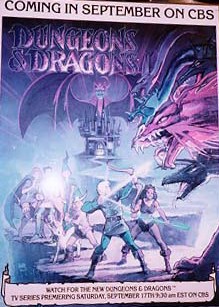 Six kids get on a carnival ride named Dungeon & Dragons and are transported into a sword-and-sorcery realm. Aided by the Dungeonmaster and a unicorn named Uni, and armed with special weapons and powers, they try to find their home and defeat the machinations of the evil Venger. Strong characters and good writing, along with voices by the likes of Adam Rich and Willie Aames (Eight is Enough) and Donny Most (Happy Days) has made this 27-episode series a classic of animated fantasy.
Ewoks
ABC, 1985-87, Nelvana & Lucasfilm
 Introduced in the hit movie Return of the Jedi, the Ewoks proved so popular that they were featured in two made-for-TV movies (The Ewok Adventure and Ewoks: Battle for Endor) before getting their own Saturday morning cartoon. The show centered around a group of young Ewoks led by Wicket, who prevailed through one harrowing adventure after another. In 1986 ABC revamped the show into The Ewoks and Star Wars Droids Adventure Hour, and the next year changed things again, producing The All-New Ewoks.
G.I. Joe: A Real American Hero
Syndicated, 1985-92, Marvel & Sunbow
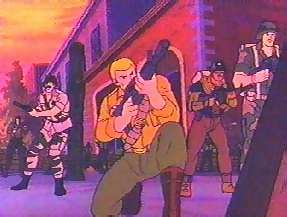 The original G.I. Joe was introduced by Hasbro in 1964 and discontinued in 1978. But in the decade of Rambo and Reagan, the concept was resurrected, this time as a group of patriotic soldiers led by Hawk. After two five-part miniseries in 1983 and 1984, the G.I. Joe team got its own cartoon series. The original cast, which included Hawk, Scarlet, Snake Eyes and of course the COBRA villains, soon grew to include dozens of characters from Ace to Gung-Ho to Roadblock to Zartan. The series was hugely popular until the late '80s, and Hasbro sold many an action figure as a result. There was also a comic book series.
He-Man and the Masters of the Universe
Syndicated, 1983- , Filmation
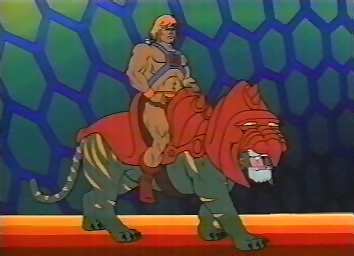 One of the most popular cartoons of the decade. He-Man was the alter ego of Prince Adam, ruler of the planet Eternia, which he defended against the evil Skeletor. A magic sword harnessed the power of the mysterious Castle Greyskull and transformed the prince into He-Man.When this happened his cowardly tiger Cringer was also changed, becoming Battle Cat. He-Man's sidekick Orko provided the comic relief. Prince Adam's sister, Princess Adora, starred in the spin-off series She-Ra, Princess of Power. Mattel profited greatly from tie-in merchandise, and there was even a live-action feature film, Masters of the Universe, in 1987. It starred Dolph Lundgren as He-Man and Frank Langella as Skeletor.
Jem & The Holograms
Syndicated, 1985-88; Marvel Productions & Hasbro
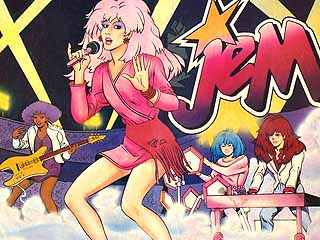 Jerrica Benton is the owner of a foster home for young girls called the Starlight Foundation. By using her magic star earrings she can transform herself into Jem, lead singer of a successful musical group called The Holograms, which includes her sister Kimber along with Aja and Shana. They travel around the world on glamorous adventures and crank out hit songs. Their chief rivals are The Misfits -- Pizzazz, Roxy and Stormer. The music was very popular with preteens, and the series ran for 65 episodes.
My Little Pony 'n' Friends
Syndicated, 1986, Sunbow & Marvel Productions
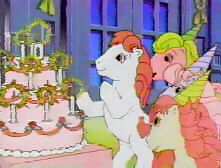 Hasbro's My Little Pony toy line spawned a couple of TV specials (1984 and 1985) before this series was launched in 1986, the same year that My Little Pony: The Movie came to theaters everywhere. The ponies -- Gusty, Shady, Lickety-Split and others -- joined forces with the Bushwoolies and Spike the pink dragon to keep Dream Valley safe from witches and trolls and the like. The show also featured The Glo Friends, Potato Head Kids and Moondreamers. My Little Pony was of the most popular toys of the '80s and is very collectible today.
Pac-Man
ABC, 1982-84; Hanna-Barbera Productions
 Based on the extremely popular video game, the series featured Packy and his family, and they're still menaced by the Ghosts under the direction of the villainous Mezmaron, who sought to capture the Power Pellet Forest, and thereby control the world. The Pac-Man craze produced school supplies, clothing, Book-and-Record sets and a very successful breakfast cereal, not to mention spawning the Ms. Pac-Man video game.
Pound Puppies
ABC, 1986-87, Hanna-Barbera
 The Pound Puppies originated as a line of stuffed animals that could be "adopted" just like the Cabbage Patch dolls. The series followed a successful 1985 TV special. Cooler, Whopper and friends operated out of a computerized headquarters below the Wagga Wagga Pound, which was run by the evil Brattina and Katrina. Their self-appointed mission was to match needy dogs with caring families. The series benefited from first-rate writing and voicework by the likes of Ruth Buzzi and Nancy Cartwright. A spin-off, The All-New Pound Puffies, aired on ABC from 1987-88. (13 episodes)
Rainbow Brite
Syndicated, 1985, Hallmark/DiC
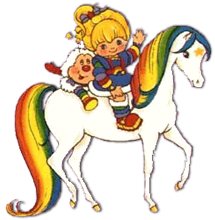 The Dark Lord had turned Rainbowland into a gloomy, dismal place, and a little girl named Wisp made it her mission to change that. With the aid of a sprite named Twink and a horse named Starlite, Wisp rescued the seven Color Kids and defeated the Dark Lord so that color and happiness could return to Rainbowland. Given the name Rainbow Brite, Wisp's next task was to make sure that the color is never again taken out of the world. Rainbow Brite was initially a creation of Hallmark Cards, circa 1983. There were several Rainbow Brite movies, as well.
Robotech
Syndicated, 1985, Tatsunoko
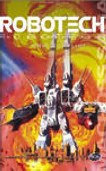 Animation expert Carl Macek adapted three Japanese cartoons into one tailor-made for American audiences. Robotech revolved around a technology for the creation of robotic armies and had three parts. In the first, Rick Hunter, Lisa Hayes and the rest of the Robotech Expeditionary Force prepared to resist the Zentraedi invasion. The second part featured Dana Sterling, an officer in the Armies of the Southern Cross, while the third told the story of the struggle against alien forces that had seized Earth. Notable for its adult themes and the fact that so many of its main characters were killed off, the show has achieved cult status. Robotech: The Movie was released in 1986.
Rubik, the Amazing Cube
ABC, 1983-84, Ruby-Spears
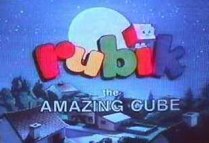 Based on the puzzle phenomenon of the '80s, this show was half of the Pac-Man/Rubik, the Amazing Cube Hour. When the cube was aligned so that all sides were the same color, it became animate; it could talk, fly, shoot magic rays, and help the three Rodriguez children in their efforts to improve conditions in the neighborhood in which they lived. The show featured music by Menudo.
Shirt Tales
NBC, 1982-84, Hanna-Barbera
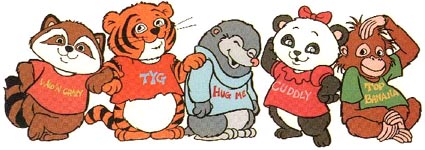 Based on a line of greeting cards, the Shirt Tales were cute little animals who lived in a tree in a park and helped park visitors, sometimes by solving mysteries. They included Tyg the tiger, Rick the raccoon and Pammy the panda. They were high-tech, too, with a supersonic transporter and wristwatch communicators with holographic functions.
The Smurfs
NBC, 1981-90, Hanna-Barbera
 The Smurfs were created in the 1950s by a Flemish cartoonist, and had become popular American toys when NBC put them on the air. The Smurfs were instant hits. A movie was produced in 1984. The show won two Emmy Awards. The Smurfs lived in mushroom houses in a little village and were menaced by the evil Gargamel, a wizard obsessed with catching the little creatures, and Gargamel's cat Azrael, who wanted to eat them.
Spider-Man and His Amazing Friends
NBC, 1981-86, Marvel Productions
 Spidey returned to TV in the '80s with a couple of college friends, Bobby Drake and Angelica Jones, who moonlighted as the superheroes Iceman and Firestar. The trio battled Spider-Man's perennial foes: Dr. Octopus, Mysterio, Kingpin and, of course, the Green Goblin. For part of its run the show was teamed with The Incredible Hulk. This was one of the most popular of the decade's superhero cartoons, with good stories, decent animation, and a lot of humorous banter between the heroic trio. The episodes were introduced by Spidey creator Stan Lee.
Strawberry Shortcake
Syndicated, 1980-85, MAD, Those Characters From Cleveland, et al.
 The character Strawberry Shortcake was a creation of the American Greetings division known as Those Characters from Cleveland. Each doll had its own scent and an animal sidekick. Every spring for five years, a Strawberry Shortcake special was aired. SS, with her friends Blueberry Muffin, Huckleberry Pie, etc., had to deal with a villain known as the Peculiar Purple Pieman of Porcupine Peak and his minions, the Sour Grapes. The specials are entitled The World of Strawberry Shortcake, Strawberry Shortcake in Big Apple City, Strawberry Shortcake: Pets on Parade, Strawberry Shortcake's Housewarming Surprise and Strawberry Shortcake Meets the Berrykins. The concept was irresistibly adorable, and the specials were a huge hit with little kids.
Thundercats
Syndicated, 1985-87, Pacific Animaton, et al.
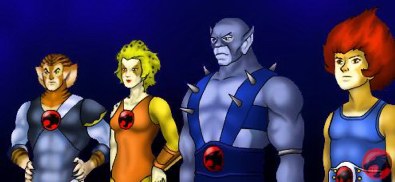 Escaping their planet prior to its destruction, the Thundercats were attacked in space by mutants and crash-landed on Third Earth. The mutants landed there, too, and allied themselves with the evil Mumm-Ra. Led by Liono, who used the Sword of Omens, the Thundercats and their Third Earth allies battled Mumm-Ra and the mutants. A series of Marvel comics and various merchandise tie-ins attest to the popularity of the show, which was a well-plotted and nicely-animated fantasy adventure. There were 130 episodes.
Transformers
Syndicated, 1984-88, Sunbow, Hasbro, Marvel Productions
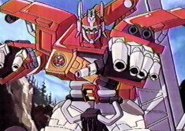 The Hasbro toys hit the shelves in early 1984 and was quickly followed that same year by a comic book series and a cartoon series. The story began with the good Autobots and the evil Decepticons landing on Earth millions of years ago. Reactivated by a volcano, they continued to wage war, aided by good and evil humans. A tremendous number of characters were introduced, and new 'bots as well -- the Dinobots and Insectibots among them. Transformers: The Movie (1986) featured voice work by none other than Orson Welles, Leonard Nimoy and Robert Stack.Intricately plotted episodes have made the Transformers a durable franchise.
Voltron: Defender of the Universe
Syndicated, 1985, World Events Productions
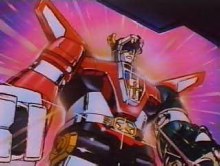 Created on an alien world as the ultimate defense system, Voltron was deceived by the witch Hagar, ally to the evil Zarkon, and separated into five lion-shaped pieces. Centuries later, with Zarkon ruling the galaxy, five space explorers discovered the pieces. United as the megarobot Voltron, they battled Zarkon and Hagar. Consisting of 52 high-quality episodes, the show was an instant hit in the U.S. and spawned a lot of tie-in merchandise as well as two subsequent series.
The Wuzzles
CBS, 1985-86, ABC, 1986-87, Walt Disney Productions
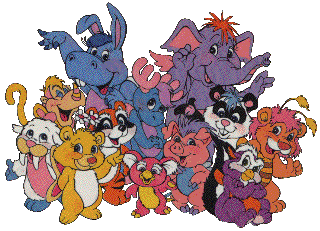 The Wuzzles were mutations of two animals in one -- Bumblelion (bumblebee and lion), Rhinokey (rhinoceros and monkey), etc. They lived in the Land of Wuz. These adorable creatures were constantly plagued by humans seeking to capture them. Despite superior animation and voice work by the likes of Jo Ann Worley, the series never really caught on, and was shuffled from CBS to ABC and then on to the newborn Disney Channel.
|